
You can’t buy happiness, but you can buy Reloder 15 … and that’s pretty much the same thing.
How Reloder 15 Edges Other Powders In Its Class:
- Medium burn rate powder, somewhere between IMR4064 and Varget
- Suitable for cartridges from the .17 up to the .375 H&H
- Can be sensitive to extreme temperature fluctuations
- The slow burn and low pressure also results in less felt recoil
- Overall, this improves the accuracy potential of a rifle shot to shot
There are many useful powders available to us handloaders, and many that are suitable across a wide selection of cartridges. Good ol’ IMR4064 and Hodgdon’s Varget are two great examples of nearly universal powders, but, as of late, I’ve been reaching for Alliant’s Reloder 15 more often than not.
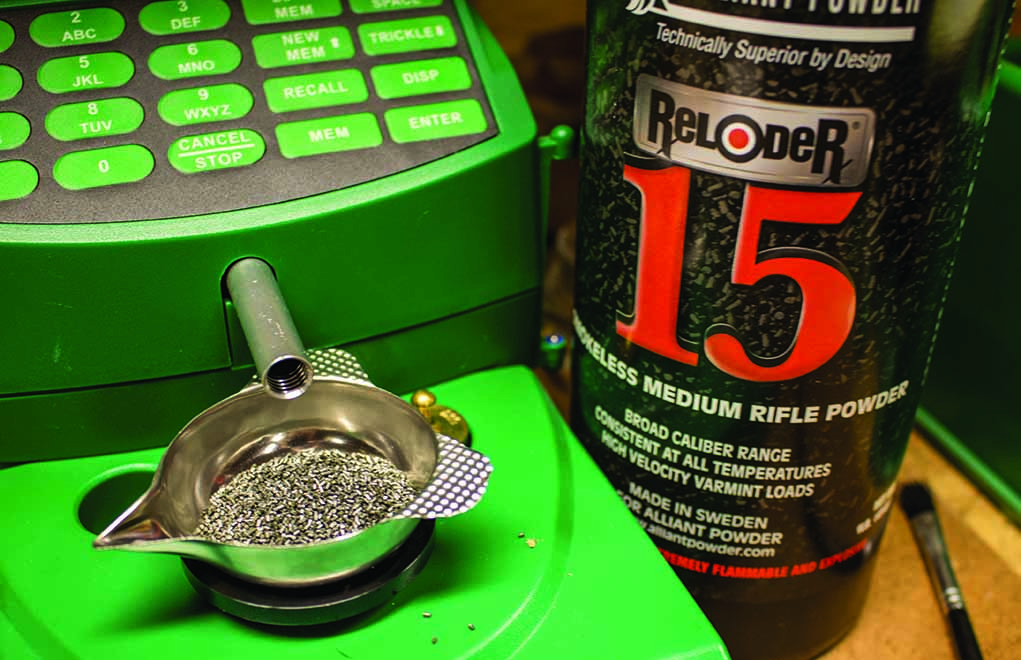
On the burn rate chart, Reloder 15 sits just about perfectly between IMR4064 and Varget, meaning that it is a medium-burning powder that can fill an awful lot of roles. As stated on the can, the powder is perfectly suited to both the .223 Rem./5.56 NATO cartridge and the .308 Win./7.62 NATO — it’s the powder loaded in the military M118LR cartridge — but that’s only the beginning.
Yes, I’ve used it in the .308 Winchester with bullets from 150 to 180 grains, with great results, but that cartridge can be fed just about anything and still perform well. It makes a great choice for both the .22-250 Remington and the .220 Swift, taking advantage of the case capacity, and generating respectable velocities in the pair of varmint classics. It also can serve well in the .308’s offspring, from the .243 Winchester up through the 7mm-08 Rem. to the .338 Federal and .358 Winchester.
Alliant gives load data for the .270 Winchester, .280 Remington and .35 Whelen, in addition to the .30-’06 parent case, and though RL-15 is on the faster end of the spectrum for those cases, it will work, and work well. It also gives good performance in some of the magnum cases, such as the WSMs, WSSMs and even the 7mm Remington Magnum and .300 Winchester Magnum, though it’s best used with the lighter bullets for the latter two cartridges.
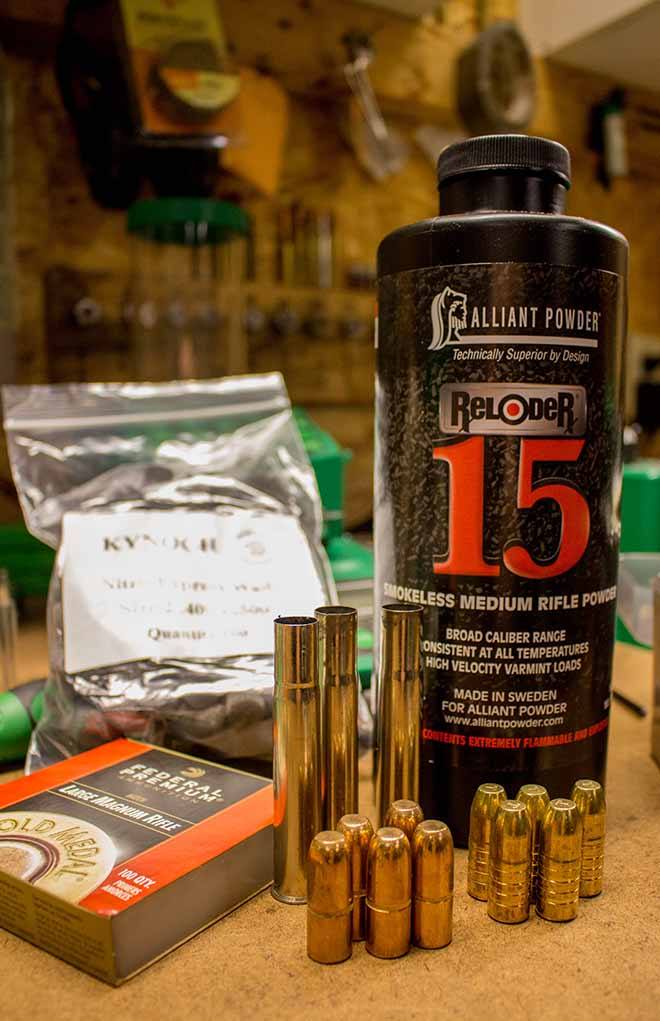
On the far ends of the spectrum, RL-15 is a good choice for the diminutive .17 Remington, as well as the .375 H&H Magnum, .416 Remington Magnum and .458 Lott; it’s a stellar choice for the .416 Rem. Mag., as that case loves powders in the RL-15/4064/Varget class. It’s also a great all-around choice for the .375 H&H for all bullet weights, giving a good blend of velocity and manageable recoil, as well as low pressure for the African heat.
Pushing The Big Boys
It’s in the bigger cases that I recently found Reloder 15 to be a huge help, as my pal Mike McNulty and I prepared for our safari to Zimbabwe. Mike was taking the first Heym Express by Martini in .505 Gibbs to roll off the line, and I was taking my Heym 89B double rifle in .470 Nitro Express. Both of us would be hunting Cape buffalo, and the October heat in Zimbabwe is notorious for being brutal, so I was concerned with keeping pressures as low as possible.
Load Up On Reloading Info:
- The Flexible And Forgiving .30-06 Springfield
- The .45 Colt: A Wheelgun Classic
- .300 Win. Mag.: The Answer To Most Hunting Questions
- Tips For Reloading the .223 Remington
The .505 Gibbs is a behemoth of a case, fully capable of digesting 140 grains of powder at a rip — and it can generate soul-crushing recoil. Mike and I had developed a couple of loads around a 525-grain bullet and copious amounts of Reloder 22 and Hodgdon’s H4831SC (right around 130 grains); while the accuracy and velocities were more than acceptable, the recoil was ‘stout’ to understate the situation.
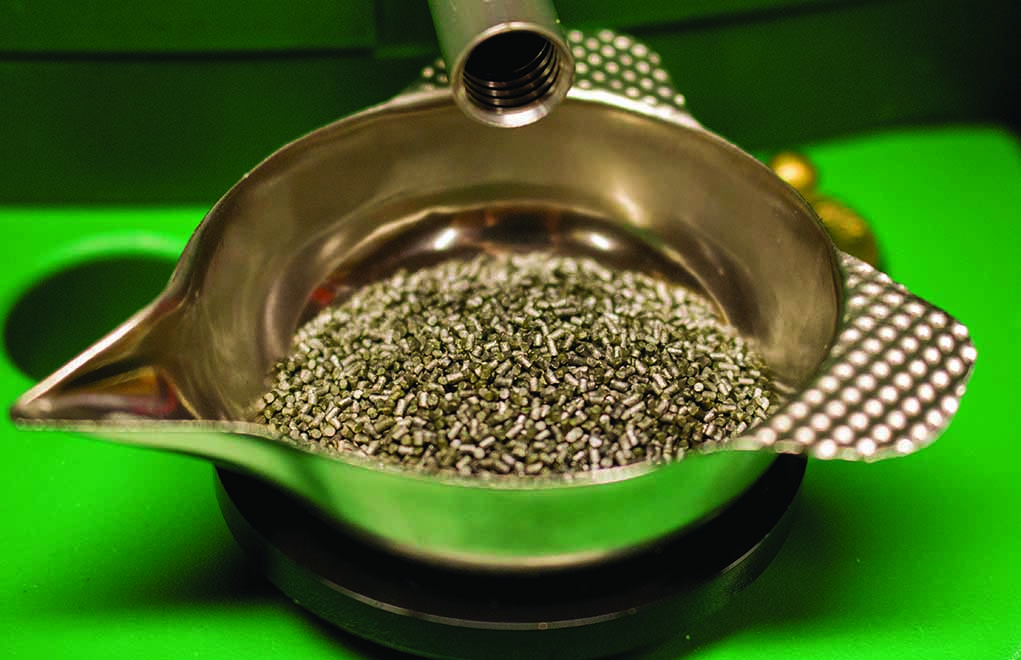
Nosing through the Woodleigh Bullets Reloading Manual — a volume that any reloader of big game cartridges should definitely have in his or her collection — I noticed there was a listing for RL-15, between 102.0 and 104.0 grains to achieve the classic velocity of 2,150 fps. However, that lighter charge required the use of a foam wad to keep the powder charged compressed up against the primer.
So, I grabbed some of the Kynoch No. 2 wads I had ordered for my .470 NE (more about that in a minute), poured out 102.0 grains of Reloder 15, and we headed to the range. The results were astounding, at least to me. We obtained ¾-inch groups at 50 yards — better than the other, slower burning powders — and yet the velocities were on par, running at 2,165 fps. But, and it’s a huge but, the felt recoil dropped off at least 15 percent; it was easily visible in the way the rifle handled at the bench. Low pressures, less recoil, and the same ballistics … what’s not to love?
Dealing With Doubles
The same principal applied to my .470 NE, though the loading process is a bit different for a double rifle than for any single barrel rifle. Double rifles are regulated to have a bullet from each barrel strike (essentially) the same point at about 75 yards, and they are regulated with a particular brand of ammunition at a particular velocity.
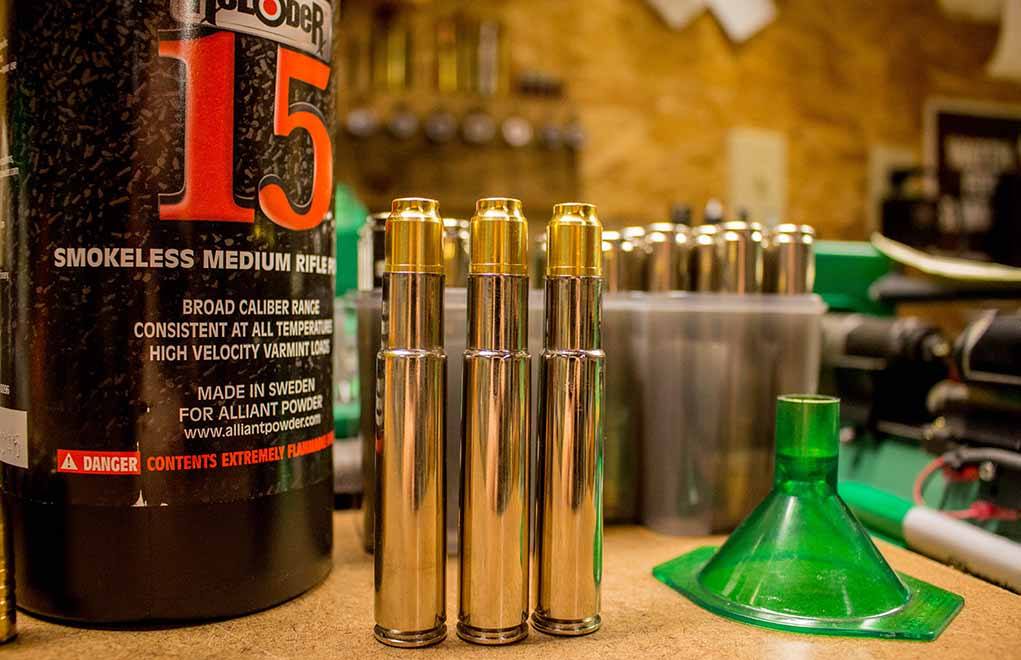
My Heym rifle was regulated with Hornady DGX-Bonded ammo, driving a 500-grain bullet at 2,150 fps, so in order to obtain the fantastic accuracy that the factory obtained — my test target showed a left and a right about ½-inch apart — I’d have to find that same velocity for my handloads. It’s a different concept, loading to a target velocity, but I quickly had it figured out.
I would be hunting with 500-grain Peregrine BushMaster soft-points and 500-grain Trophy Bonded Sledgehammer solids, and instead of the slower burning H4831SC, RL-22 or RL-25, I once again leaned on Reloader 15 for the reduction in recoil. I loaded up sets of cartridges in one-grain increments from 87.0 to 90.0-grain charge weights, and I sat down with my Oehler 35P chronograph.
The pairs of bullets — one each from each barrel — would tell the tale of what my double preferred, as they would probably start out low and wide at the bottom end of the spectrum, rise and come together as the rifle showed what it prefers, and finally rise higher and separate as velocities continue to increase.
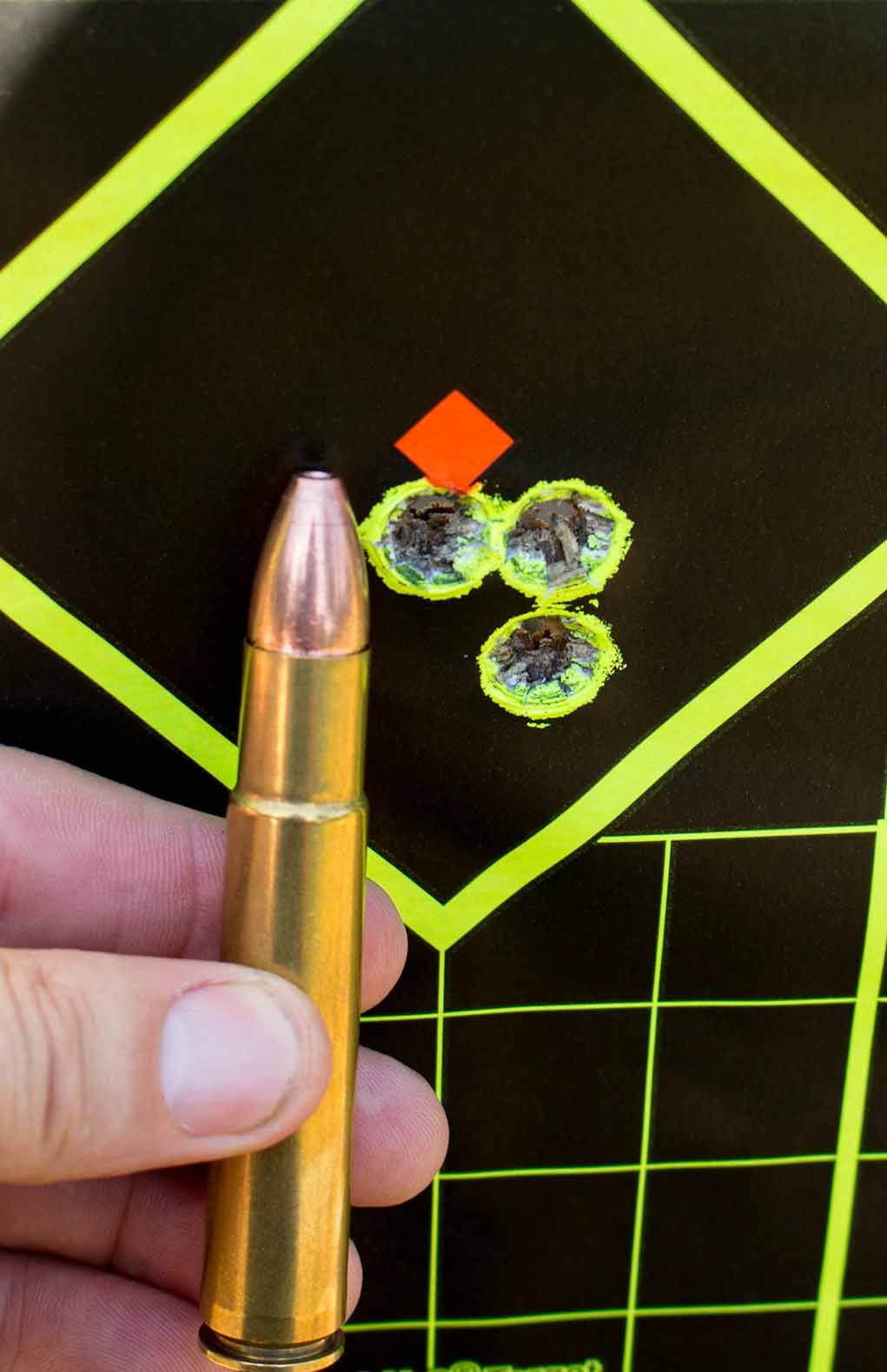
aren’t accurate? The .505 Gibbs and Reloder 15 should surely convince you otherwise.
Without boring you with all the data, 88.0 grains of RL-15 gave me 1¾-inch pairs, with the velocity matching the Hornady load within 15 fps and a velocity spread of 8 fps. Comparing these cartridges with the H4831SC loads — which gave more than acceptable results — the felt recoil again dropped off considerably, while I easily made the target velocity of 2,160 fps. Two good Cape buffalo bulls fell quickly to the Peregrine/Sledgehammer combination, despite the 112-degree Zimbabwean heat.
A Note On Temps
Reloader 15 has been criticized for being a bit sensitive to temperature fluctuations, and I can see where a shooter might be concerned in extreme cold or hot situations. I did my load development in 90-degree heat, leaving the ammunition in the sun in order to best prepare for my safari, so there was no real noticeable difference in point of impact due to the increased temperatures. Were I preparing to take this rifle into an environment where temps were in the 40-50 degree range, I would definitely measure the velocities in the cooler air, and possibly make an adjustment in charge weight for the double rifle. Such is the nature of the beast.
If you’re loading for a good number of cartridges, including the ones I’ve mentioned throughout this article, Reloder 15 can easily be the universal answer to a lot of reloading questions; take a look at the rifle cartridges you load for, and I’d be willing to bet if they’re in the middle of the road, you can make Reloder 15 work for you.
Editor's Note: This article originally appeared in the December 2018 issue of Gun Digest the Magazine.

Next Step: Get your FREE Printable Target Pack
Enhance your shooting precision with our 62 MOA Targets, perfect for rifles and handguns. Crafted in collaboration with Storm Tactical for accuracy and versatility.
Subscribe to the Gun Digest email newsletter and get your downloadable target pack sent straight to your inbox. Stay updated with the latest firearms info in the industry.

![Best Concealed Carry Guns In 2025 [Field Tested] Wilson Combat EDC X9S 1](https://gundigest.com/wp-content/uploads/Wilson-Combat-EDC-X9S-1-324x160.jpg)


![Best 9mm Carbine: Affordable PCCs [Tested] Ruger Carbine Shooting](https://gundigest.com/wp-content/uploads/Ruger-Carbine-Shooting-100x70.jpg)
![Best AR-15: Top Options Available Today [Field Tested] Harrington and Richardson PSA XM177E2 feature](https://gundigest.com/wp-content/uploads/Harrington-and-Richardson-PSA-XM177E2-feature-100x70.jpg)
